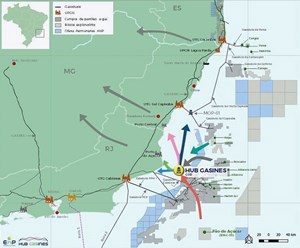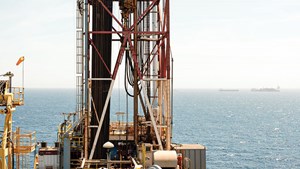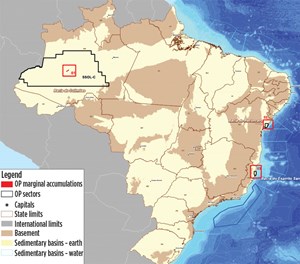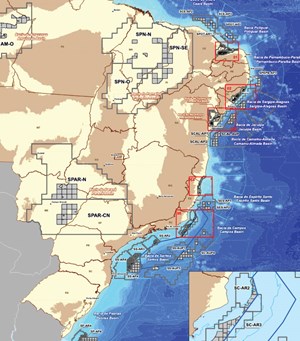Regional Report: Brazil
Despite a Covid-19 hit that sidelined many field operations, Brazil’s 2020 mid-year figures appeared to put production on track for another yearly gain dominated by the pre-salt.

The performance follows government initiatives in recent years aimed at reversing declines in overall production. While pre-salt production between 2012 and 2018 rose a remarkable 729%, onshore production fell 38% and post-salt Campos basin oil production fell 41%.
The latest government numbers for August, released in October, have total production at 3.927 MMboed, made up of 3.087 MMbopd and 134 MMcmgd. Oil production increased 0.3%, compared to the prior month, and 3.3% over August 2019. Natural gas increased 2.4% versus July’s level and 0.1% over the prior year’s August figure.
The August 2020 pre-salt total accounted for 70.7% of the country’s production. In 2019, when oil production first pushed past the 3.0 MMbpd mark, November pre-salt oil was 2.061 MMbpd or 66.7% of the total production.
The August pre-salt production marked a second consecutive month of record numbers, with a total 2.776 MMboed, based on 2.201 MMbopd and 91.398 MMcmgd. The gain was 1.4% over the previous month and 14.4% over August 2019’s pre-salt production, according to the National Agency of Oil, Natural Gas, and Biofuels (ANP).
The gains come, even with Covid-19 issues that in August temporarily halted production from 33 fields. The shutdown involved 16 offshore and 17 land assets, while production in 60 maritime facilities remained interrupted. The pandemic halted operations on two FPSOs, Mangaratiba and Cidade de Angra dos Reis, and restricted production at oil facilities P-67, P-74 and P-76, said ANP.
In May 2020, the agency reported a 6.5% production fall from April, which still amounted to a 1.3% increase year-on-year. Natural gas monthly production dropped 7.8%, which was down 3% from the prior year. In May, daily output was 3.485 MMboe, made up of 2.765 MMbopd and 114 MMcmgd.
Offshore fields accounted for 96.9% of the oil and 85.5% of the natural gas. Fields operated by Petrobras accounted for 94.7% of the oil and natural gas produced in Brazil, while fields controlled exclusively by Petrobras produced 42.9% of the total.
LEASE SALES
17th Bidding Round. Temporary suspension of the 17th bidding round scheduled for this year, was announced last April. The suspension was in compliance with a request from the Ministry of Mines and Energy (MME), due to the Covid-19 pandemic.
ANP anticipates that the 17th Bidding Round will occur in 2021. In mid-November 2020, it published the draft tender protocol and concession agreement. The drafts discuss 92 blocks, distributed in four sedimentary basins, that the government considers high-potential areas, as well as new exploratory frontiers that present an opportunity for large and medium-sized companies, Table 1.
Open acreage. The public bidding session for Second Cycle of Open Acreage on Dec. 4 saw purchases in seven of 10 basins offered. Exploratory sales involved 17 blocks in the Amazonas, Campos, Espírito Santo, Paraná, Potiguar and Tucano basins. The total bonus offered was R$ 30,936,646.00 and the minimum investment expected in the exploration phase is R$ 157,002,000.00.
Marginal Accumulations sales occurred for the onshore Solimões basin’s Juruá oil fields. The total bonus offered was R$ 25,760,000.00, and the minimum investment forecast is R$ 3,600,000.00.
There were no bids in the remaining Santos, Recôncavo, and Sergipe-Alagoas basins.
Winners by basin included:
- Amazonas–Eneva S.A. (100%) won two blocks
- Campos–Shell Brasil Petróleo Ltda. (100%) won a single block
- Espírito Santo–seven blocks were won by a 50/50 consortium of Imetame Energia Ltda (operator) and ENP Ecossistemas Energéticos Holding S.A.
- Parana–four blocks were won by a consortium of operator Eneva S.A. (70%) and Enauta Energia S.A. (30%)
- Poiguar–PetroRecôncavo S.A. (100%) won a single block
- Tuscano–Petroborn Óleo e Gás S.A. (100%) won a single block
- Solimões basin–two areas were purchased by Eneva (100%) and Imetame (100%)
The Open Acreage regime deals with exploratory risk blocks and areas with marginal accumulations for exploration or rehabilitation and production. It also includes the continuous offer of returned fields and exploratory blocks, as well as exploratory blocks offered in previous rounds and not sold.
In May, ANP approved Open Acreage that includes 708 exploratory blocks with exploratory risk, and three areas with Marginal Accumulations. That includes 519 blocks remaining after the 1st Cycle of the Open Acreage; 24 blocks not auctioned in the 16th Bidding Round; 149 blocks under study for environmental feasibility; and 16 blocks from the SAM-O western onshore sector that were ratified by the National Indian Foundation (FUNAI).
The areas with marginal accumulations include two remaining coastal onshore areas of the 1st Cycle of the Open Acreage (SREC-T4 Miranga Leste in the Recôncavo basin, and SES-T6 Rio Ibiribas in Esptiro Santo basin, and one in the western onshore SSOL-C-Juruá Amazonas area), Fig. 1.
The number of offered exploratory blocks differs from earlier discussions, said ANP. It now includes 16 exploratory blocks ratified by FUNAI, and excludes 48 exploratory blocks already included in the current Tender Protocol, changing the total from 567 to 519 remaining blocks.
The excluded blocks with exploratory risk are in the Ceará basin (one block from Sector SCE-AP3); Espírito Santo basin (three blocks from Sector SES-T6); Parnaíba basin (three blocks from Sectors SPN-N =and SPN-O); Potiguar basin (14 blocks from Sectors SPOT-T3, SPOT-T4, SPOT-T5); Recôncavo basin (26 blocks of the SREC-T1 and SREC-T4 Sectors); Tucano basin (1 STUC-S Sector block) already included in the current Tender Protocol, Fig. 2.
POTENTIAL FIELDS
ANP is currently inspecting fields with marginal accumulations to include them in the permanent offer. The objective is to inventory and evaluate the conditions of the wells and other existing structures.
Initial inspections announced in March 2020, were for onshore assets in Barra do Ipiranga, Jacupemba, Mariricu Oeste, Nativo Oeste, Rio Barra Seca, Rio Ibiribas, Rio Itaúnas Leste and Rio São Mateus Oeste, located in the Espírito Santo basin. The agency plans to periodically conduct the inspections, based on the availability of new areas with marginal accumulations.
COMPANY HIGHLIGHTS
Petrobras. A surge in oil exports and divestments is projected by Petrobras in the next five years, as it takes aim at overseas demand and cutting debt. In November, the company told investors that it expects domestic oil sales to drop to 1.252 MMbpd from 2021 to 2025, versus 1.348 MMbpd in the five years ending in 2019. But crude exports are forecast to gain, to an average 891,000 bpd from the 445,000 bpd that the company averaged in the five-year period ending in 2019.
The company plans to divest $25 billion to $35 billion in assets from 2021 to 2025, up from the $20 billion to $30 billion in divestments projected for 2020-2024.
Petrobras said it was beginning the non-binding phase for the sale of 50% of its stakes in the Marlim, Voador, East Marlim and South Marlim concessions (the Marlim Cluster), located predominantly in deep waters in the Campos basin.
Buyers will receive instructions on the divestment process, including guidelines for the preparation and submission of non-binding proposals, as well as access to a virtual data room containing additional information about the Cluster.
The Marlim Cluster comprises four production concessions in the Campos basin. Petrobras operates the fields with a 100% stake.
Marlim and Voador fields cover an area of 339.3 km2. They are in deep waters ranging from 400 m to 1,050 m, and are about 150 km from Macaé, on the northern coast of the state of Rio de Janeiro. Marlim and Voador share the production infrastructure. Between January and November 2020, they produced an average 65,300 bopd and 885,000 cmgd.
Marlim Leste field is east of Marlim field, and about 107 km from Cabo de São Tomé. It is in deep and ultra-deep waters, where water depths range from 780 m to 2,000 m. From January to November 2020, Marlim Leste produced an average 39,400 bopd and 633,000 cmgd.
Marlim Sul field is south of Marlim and Marlim Leste fields, at a distance of about 90 km from the northern coast of Rio de Janeiro. It sits in deep and ultra-deep waters, in water depths that vary from 800 m to 2,500 m. The field produced on average, from January to November 2020, about 109,600 bopd and 2.073 MMcmgd.
Early in 2020, Petrobras signed with Energizzi Energias do Brasil Ltda for the $ 1.5 million sale of its entire stake in the Rabo Branco onshore field, in the Sergipe-Alagoas basin, in the State of Sergipe. Rabo Branco field is part of the BT-SEAL-13 concession, south of Carmópolis field in the Sergipe-Alagoas basin, Sergipe State. Petrobras has a 50% stake in Rabo Branco field, in partnership with operator Petrom that has the remaining 50%. From January to October 2020, the field averaged 138,000 bopd.
Petrobras last March sold 100% of its stakes in four onshore fields in the Tucano basin, in the state of Bahia, to Eagle Exploração de Óleo e Gás Ltda (Eagle)
for US$ 3.173 million. The onshore fields, Conceição, Quererá, Fazenda Matinha and Fazenda Santa Rosa, are about 110 km from the city of Salvador. Average production of these fields from January to October 2020 was approximately 24,300 cmgd, with no oil production.
EnP. Newly-formed Energy Platform (EnP) acquired Espírito Santo exploratory blocks ES-T-305, 409, 429, 466, 486A, 517 and 527 in the December Open Acreage sale. The acquisition was through subsidiary EnP Ecossistemas Energéticos, in partnership with Imetame Energia (50%). Launched last March, the company described the acquisitions as part of an integrated regional portfolio strategy. Its initial focus on Espírito Santo is comprised of E&P assets, gas infrastructure (UPGN Lagoa Parda and Hub Gasines), and modular refineries (RefinES and RelubES).

“EnP consolidates its presence in the onshore capixaba and demonstrates, once again, its belief in the attractiveness of onshore exploration and production in Brazil,” said CEO Marcio Felix. The assets add to its basin portfolio where, in November, the company acquired interests in five onshore exploration blocks (ES-T-354, 373, 441, 477, and 487), including April’s Vida discovery, where 2021 drilling is planned. The company also has interests in Lagoa Parda, Lagoa Parda Norte, and Lagoa Piabanha fields.
EnP’s Hub Gasines project will collect gas from multiple producers and move it to existing and planned treatment units in Rio de Janeiro and Espírito Santo, Fig. 3. Aimed at pre-salt and post-salt gas production from the southeastern coast of Brazil, the project includes flow network interconnection and flexibility; use of available gas processing and transport capacities; alternative to injection; and gas storage facilities.
An operation and distribution center (ODC) is planned in shallow water, near the border between the states of Espírito Santo and Rio de Janeiro.

Equinor. Baker Hughes, Halliburton and Schlumberger were awarded contracts for drilling and well services on Bacalhau (formerly Carcará) field by Equinor and partners ExxonMobil and Petrogal Brasil, Fig. 4. The three contracts, estimated at $455 million, are for four years and two, two-year options. “The awards build further on our positive cooperation experience with the three selected suppliers in our projects worldwide. They will be essential to ensure safe and efficient drilling and well operations on the Bacalhau field,” said Peggy Krantz-Underland, Equinor’s chief procurement officer.
Earlier in the year, Equinor initiated Front End Engineering and Design (FEED) contracts with early commitments and pre-investments for phase 1 of Bacalhau. Contractors have been selected for the subsea, umbilical, risers and flowlines (SURF) and the floating production, storage and offloading (FPSO) contracts. Subsea Integration Alliance (SIA), formed by Subsea7 and OneSubsea, was selected for the SURF contract; and MODEC Inc. was awarded the FPSO contract.
“Awarding these contracts is an important milestone in developing the Bacalhau area,” said Anders Opedal, Equinor’s executive vice president for Technology, Projects & Drilling. “We have awarded these contracts to reputable companies with long experience in Brazil, and we are now looking forward to further collaboration with SIA and MODEC, to ensure a timely execution of the project.”
The SURF and FPSO contracts are based on a two-step award. The FEED and pre-investment started in January, with an option for the execution phase under a lump sum turnkey contract setup, which includes engineering, procurement, construction and installation for the entire SURF and FPSO scopes.
During 2021, Equinor plans to begin production from the second phase of its Peregrino field in the Campos basin. The field is the company’s largest operation outside Norway. Phase Two adds a third, fixed wellhead platform to the field. Equinor (operator, 60%) and Sinochem are joint-owners.
The oil field is in licenses BM-C-7 and BM-C-47, in water depths of 100 m. Peregrino is Equinor’s largest operated oil field outside Norway and has a production capacity of 100,000 bpd. The field concession runs to 2040. The second phase involves the Peregrino southwest area, which is not accessible by the existing A and B platforms.
The field will be developed using horizontal production wells, with artificial lift that will be provided by subsurface downhole electric submersible pumps (ESPs). Multiphase export booster pumps will be installed to pump oil, gas and water that will be carried by export pipelines to the existing FPSO.
Shell Brasil in December extended the FPSO Espirito Santo lease, operation and maintenance contracts. According to MISC Bhd, the five-year extension is with its two joint venture companies, Brazilian Deepwater Production Ltd and Brazilian Deepwater Production Contractors Ltd. Its partner in the venture is SBM Holding Inc.
The largest foreign producer in Brazil, Shell said in August that the Libra Consortium, operated by Petrobras, would contract the Mero-3 FPSO for the Mero field in the offshore Santos basin. It is the third production system deployed in Mero field. Each unit has an operational capacity rate of 180,000 boed, with production coming online over the next four years. The Pioneiro de Libra FPSO (50,000 boed) has been producing since 2017 and is a key source of information for the consortium to aid further development and productivity of the field, reservoir and wells.
ExxonMobil. Brazil and Guyana are ExxonMobil’s key E&P focus, the company said in a December Rio Oil & Gas 2020 digital conference. In Brazil, the company planned a January start to a two-well drilling program from the Seadrill drillship West Saturn. It will drill the Opal wildcat in Block C-M-789 in the Campos Basin, and the Titan prospect in the Tita pre-salt area of the Santos basin. Also, on the list for the second half of the year, is an exploration well at the deepwater section of the Sergipe-Alagoas basin.
- From injection to insight: Tracing efficiency in surfactant huff and puff (November 2025)
- Maximizing production with smarter lift solutions (November 2025)
- Breakthroughs in geothermal drilling: Eavor’s FOAK closed-loop commercial project in Germany (November 2025)
- Production technology: How a minor instrument upgrade led to major oil separator savings (November 2025)
- What LNG and AI mean for drilling in 2030 (November 2025)
- Engineered components are the difference between survival and failure in HPHT subsea systems (November 2025)
- Subsea technology- Corrosion monitoring: From failure to success (February 2024)
- Applying ultra-deep LWD resistivity technology successfully in a SAGD operation (May 2019)
- Adoption of wireless intelligent completions advances (May 2019)
- Majors double down as takeaway crunch eases (April 2019)
- What’s new in well logging and formation evaluation (April 2019)
- Qualification of a 20,000-psi subsea BOP: A collaborative approach (February 2019)





